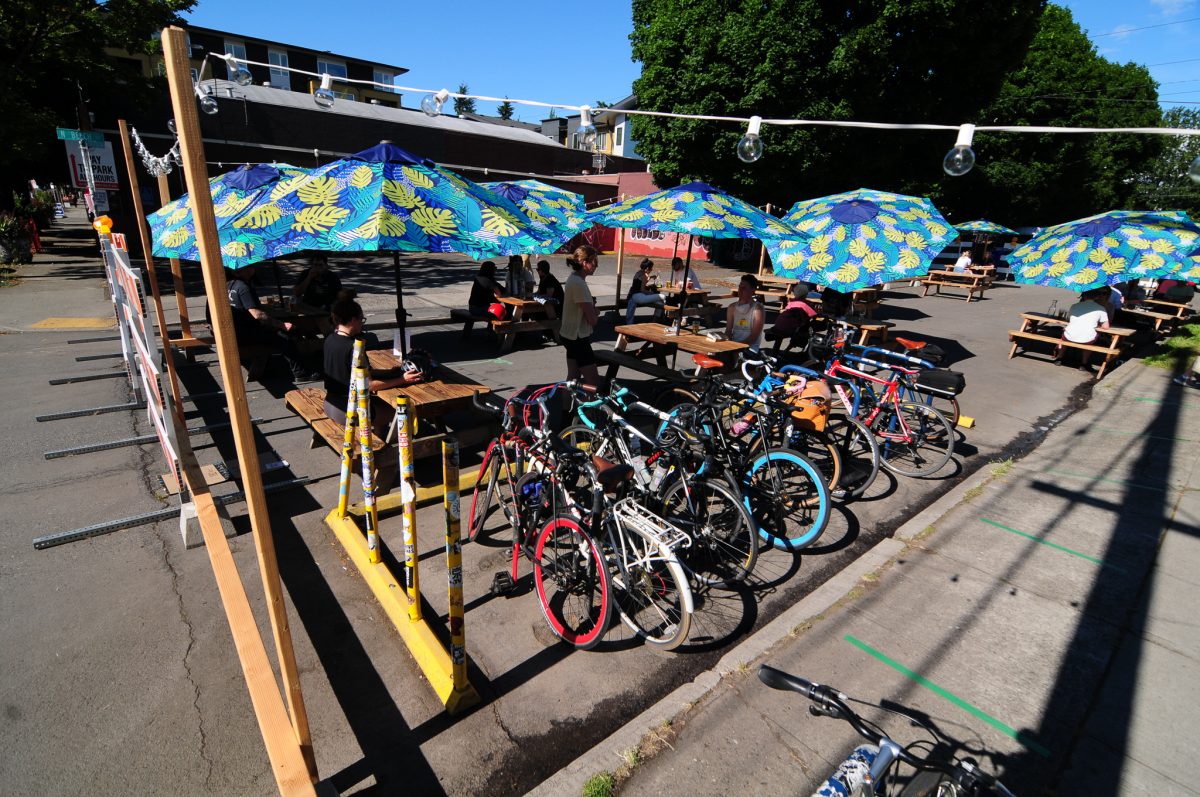
(Photos: J. Maus/BikePortland)
For years local transportation reform activists have pushed City of Portland to go beyond car storage and driving and think more creatively about what we can do with our streets. And when calls for new uses of street space were made, it was often restaurant owners who lined up to say their business would perish without maximum access for car users.
Then a pandemic hit and relatively overnight we’ve seen the most robust transformation of public right-of-way in Portland’s history. I’m talking about the new Healthy Business permit program that launched last week.
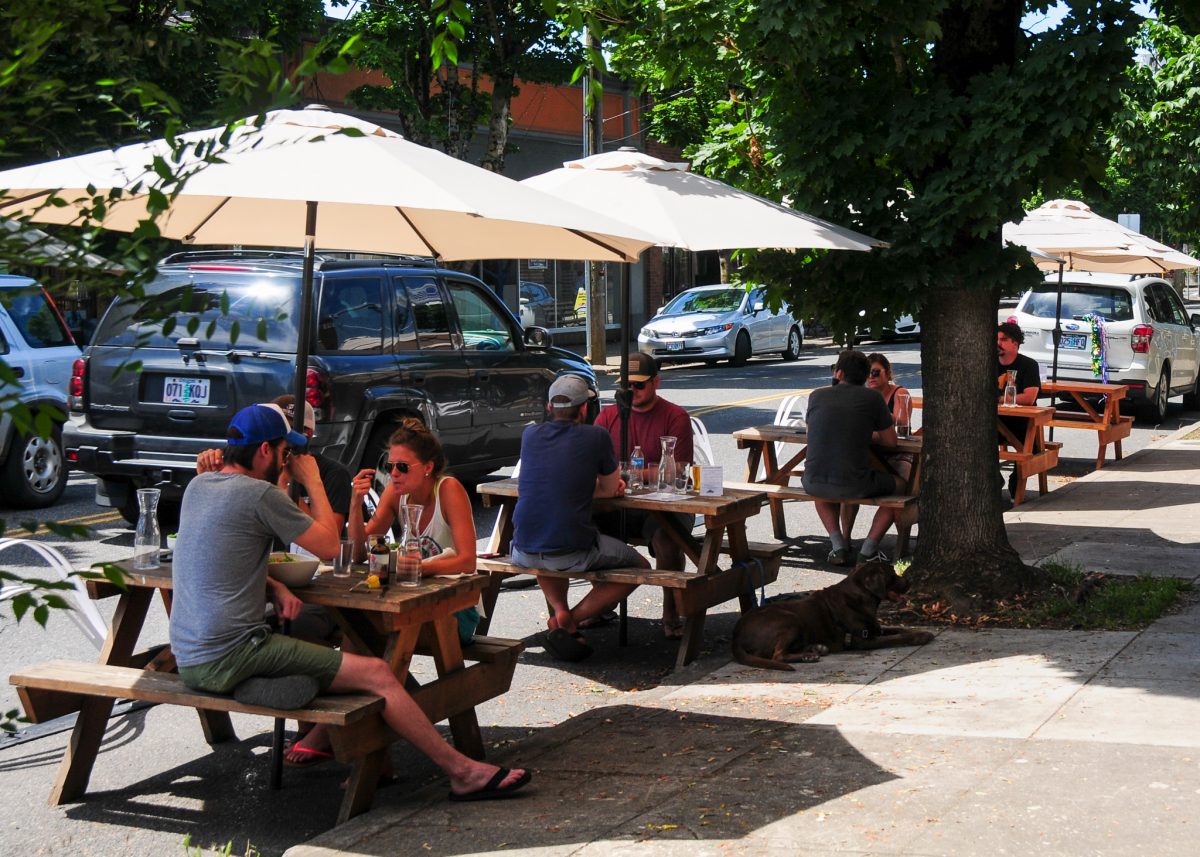
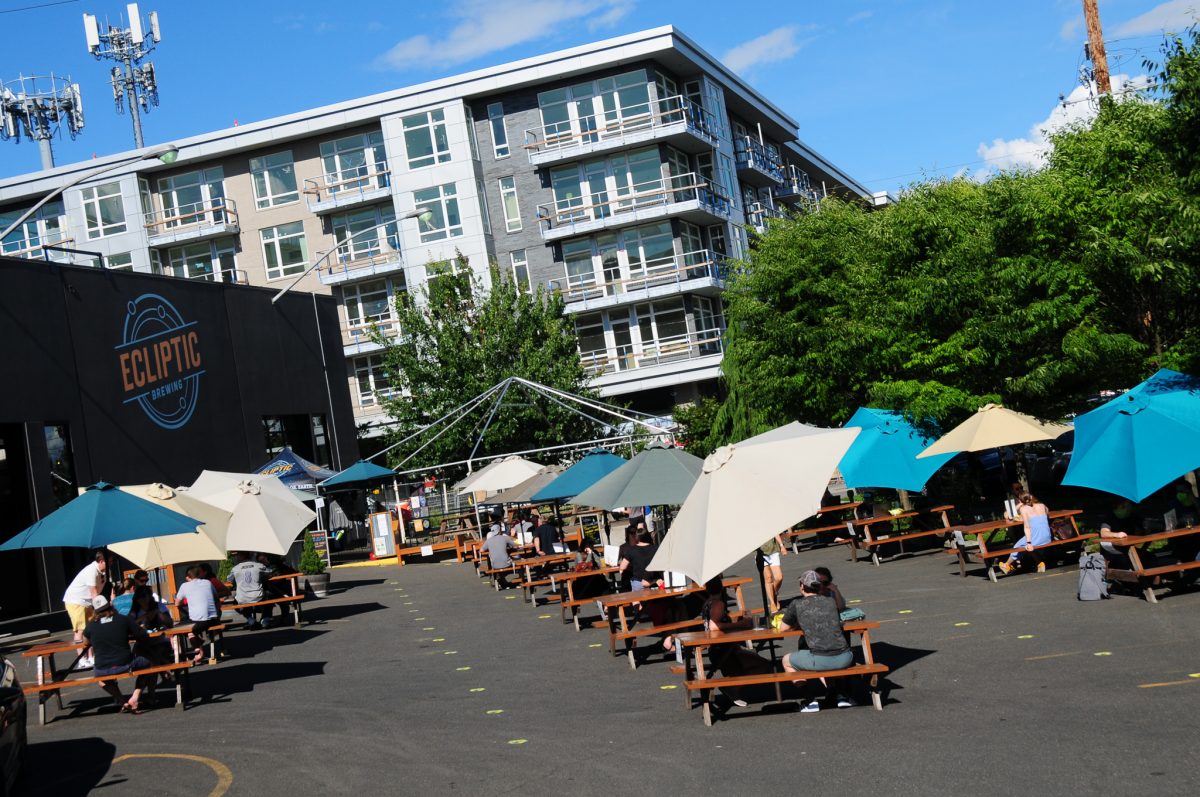
With nearly 200 permits issued so far, restaurant owners have wasted no time turning parking lots, parking spaces, and even streets into dining areas. A map of who’s received permits shows the program has been very popular with businesses along popular commercial corridors such as Lombard in St. Johns and Stark Street in Montavilla.
Judging from photos in news reports and crowds I’ve seen, the new seating arrangements have been popular with customers too. But as good as these street seats and plazas are for the local economy and comfort of patrons, the program has also raised concerns.
Advertisement

We’ve noticed worries about the geographic equity of the permits, the “privatization” of these spaces, and health concerns given the ongoing Covid-19 pandemic.
If you take a closer look at the official PBOT map of permit locations (above), you see big gaps. This is expected given Portland’s “streetcar suburbs” and the healthy business districts they’ve helped create. It’s also troubling from an equity and housing affordability perspective. Home prices in these areas have skyrocketed in the past decade, forcing many Portlanders into parts of the city where no permits have been issued. That means people with less money have to travel further to take advantage of these restaurant plazas. If they rely on transit they’ll have to take a health risk and contend with major TriMet service cuts due to the pandemic.
These new plazas also create a jarring juxtaposition of people using streets to down IPAs and hamburgers, while many Portlanders march on these same streets in an ongoing battle to end racism and police brutality. I’m reminded of the now famous viral tweet from Ziwe Fumudoh where she wrote: “there are two americas: one fights for black lives and the other fights for brunch” and shared an image of protestors next to young white people dining.
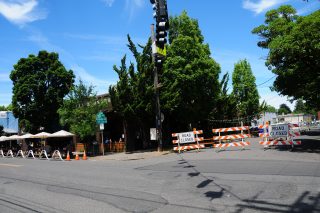
And who has access to these spaces? When PBOT created the Ankeny Alley plaza downtown many people grumbled that they handed too much control over the space to adjacent businesses — at the expense of the (non-paying customer) public. This time around, the street space is to remain public* (*nope, see update below) and PBOT requires a minimum 11-foot lane for through traffic at all times.
Then there’s the pandemic. Just as foot, bike and car traffic on our streets has increased in recent weeks, so too has the number of Covid-19 infections (and 43% of them are people of color).
Multnomah County Commissioner (and emergency room doctor) Sharon Meieran told the Willamette Week today that Portland is definitely not out of the woods with this virus. Not even close. “We have become tired of this disease, and we’re not even through the first wave. The disease is not tired of us,” she said.
Then there’s Jim Blackwood, a former senior policy director for the late City Commissioner Nick Fish. He wrote in an op-ed in the Tribune today that the plazas are “perilous” during the pandemic. While he’s conflating these PBOT-sanctioned plazas with the larger-scale plans being pushed by The Portland Promenade Project, Blackwood raises the point that public health will suffer because social distancing at them will be “erratic at best”.
One thing there’s no denying is that this program forces Portland to re-think how we use public streets. And for people who’ve dreamed of reducing access for car drivers, they’re an important step forward.
Have you seen or used any of these plazas? What was your experience? How can the city make this program last beyond the pandemic and create similar programs for uses beyond dining?
UPDATE, 3:52pm: PBOT has clarified a question we had about public access to these spaces. Here’s how PBOT Communications Director John Brady explains:
“The permit holder manages the spaces and makes the decisions about how it is used and who can use it. It’s not a public space in that sense.”
That feels like a problematic arrangement that could result in people being denied access to these spaces based on whether or not they are buying something and/or based on the whim and biases of a particular business owners. We’ll be monitoring the situation.
— Jonathan Maus: (503) 706-8804, @jonathan_maus on Twitter and jonathan@bikeportland.org
— Get our headlines delivered to your inbox.
— Support this independent community media outlet with a one-time contribution or monthly subscription.



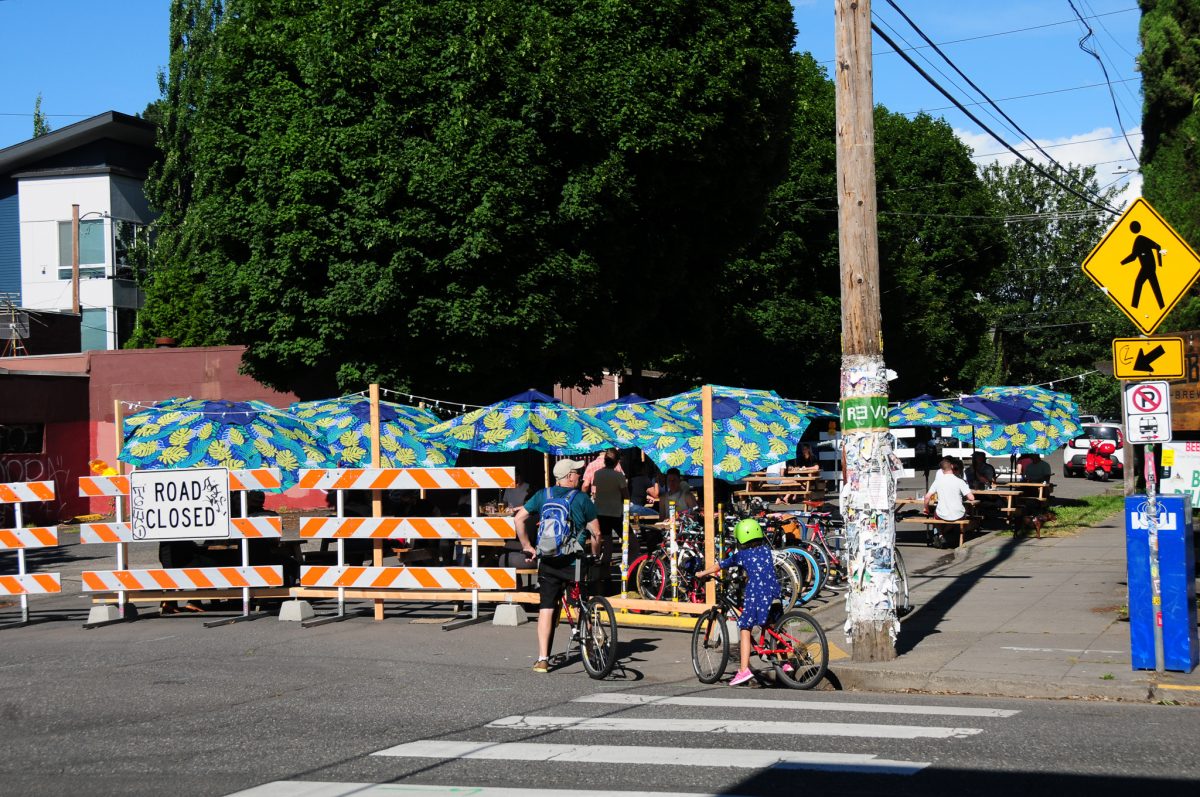


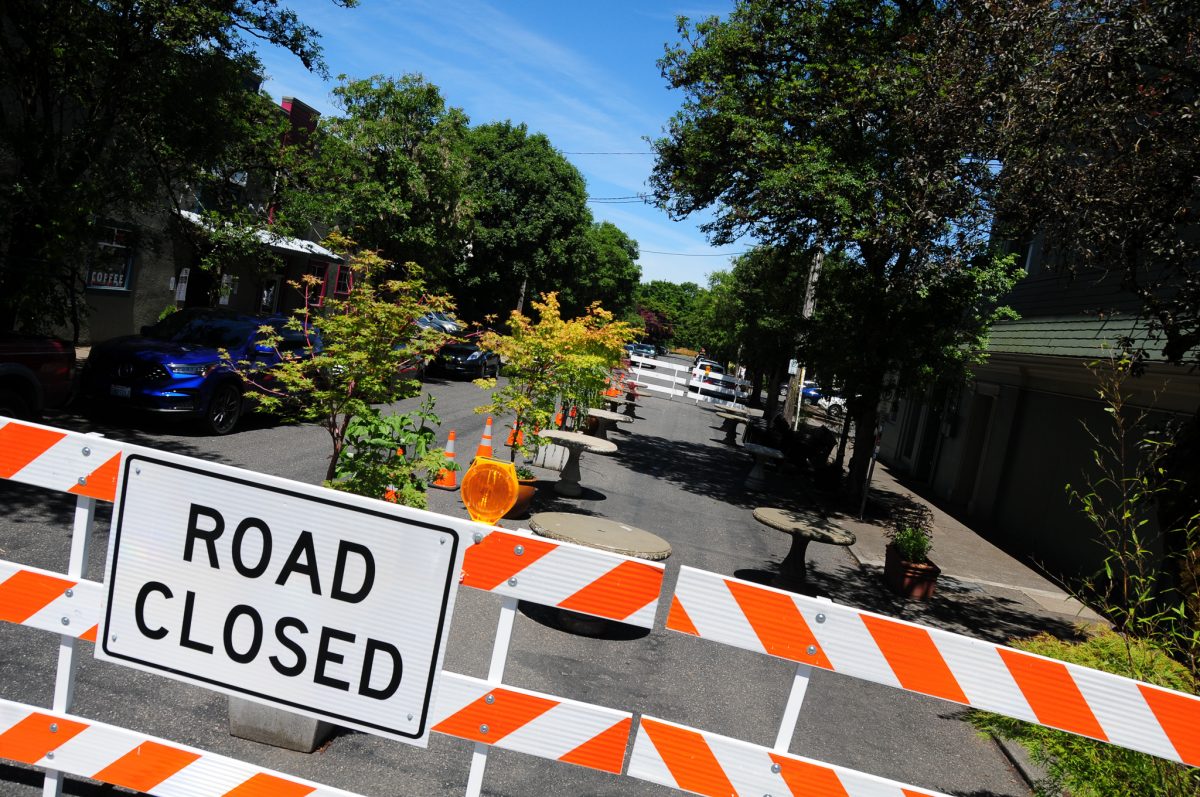
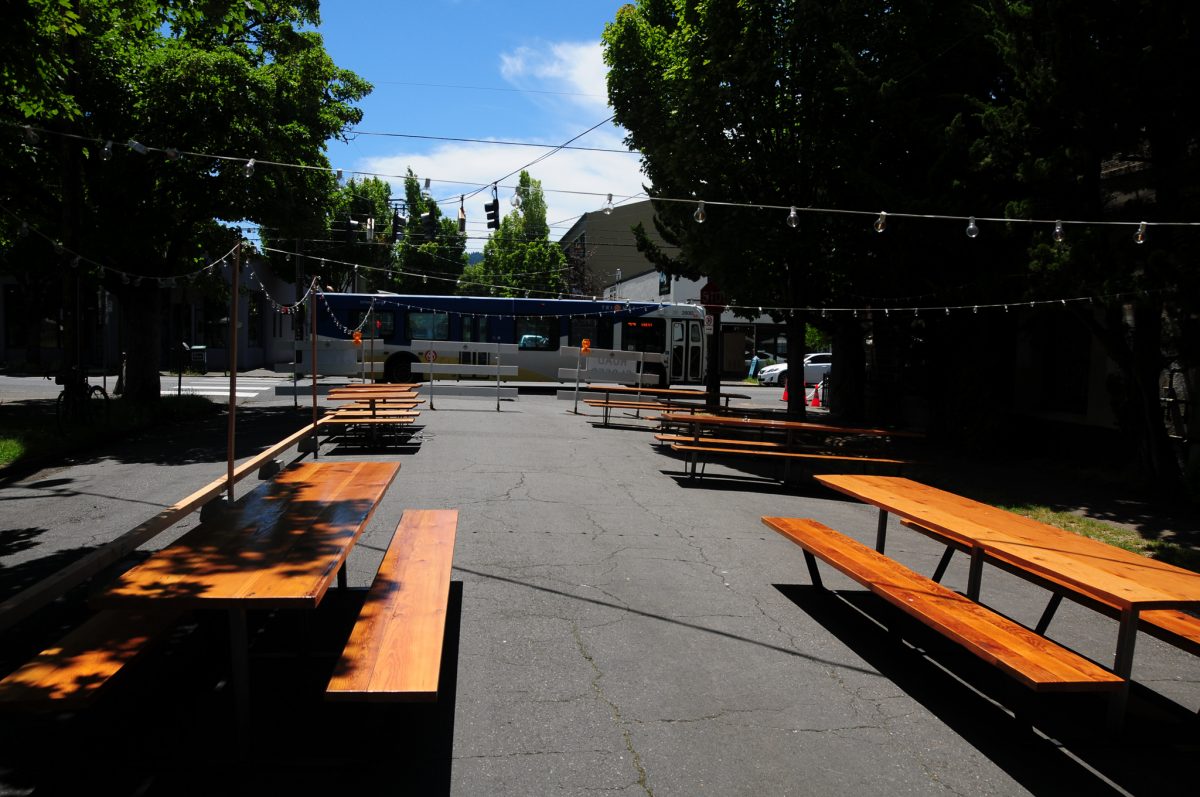
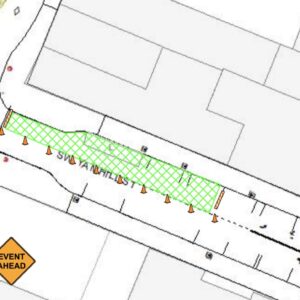
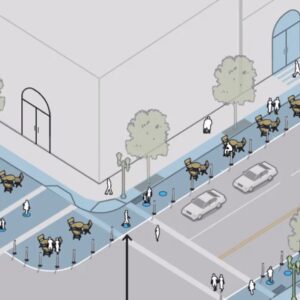
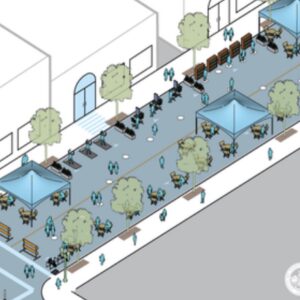
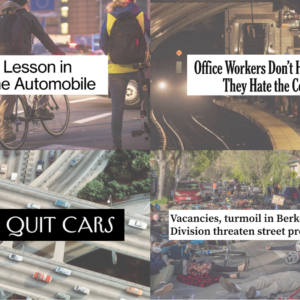
Thanks for reading.
BikePortland has served this community with independent community journalism since 2005. We rely on subscriptions from readers like you to survive. Your financial support is vital in keeping this valuable resource alive and well.
Please subscribe today to strengthen and expand our work.
Not so much a transformation but a practical reconfiguration to deal with a temporary situation.
There are a lot fewer people driving than before, and they’re not going as far or as to as many places. This means the roads are more open for any use. Meanwhile, some services (restaurants in particular) can only be provided safely if there is more space. So allowing them to do this makes sense for everyone.
I’m skeptical of transforming large numbers of streets to other purposes. Ignoring that paving over every living thing is pointless if you don’t need a surface that trucks can roll on, people really don’t expose themselves to the elements except when the weather is close to perfect. Even the tiny bit of warmth we’ve gotten this week in otherwise glorious conditions has had a massive impact on the number of people in parks and streets choked off for local use.
It does, and that’s a good thing. The takeaway I’m getting so far is that everyone wins if their configuration is driven by realistic as opposed to aspirational use.
Even people who fight for black lives need to eat sometime. Why not brunch?
Yes. And wouldn’t it also be nice if we were using our street space to eliminate—or better support advocacy to eliminate—civil rights violations, harassment, and hate crimes that occur in it?
Open 28th for people.
People = Mostly white people with higher incomes
Yes. Those are the people who live near 28th. What is your point?
“Yes. Those are the people who live near 28th.”
This kind of erasure of poor people is one of the main reasons that cycling advocacy is such a political flash point in this community.
We absolutely do not want people spending money in the city.
I don’t really understand the geographic concerns that people keep bringing up. The purpose of these plazas and street seats is to provide or expand outdoor seating in areas where businesses don’t have enough space for outdoor seating otherwise. In most areas of East Portland or other auto-oriented parts of town, most businesses have these huge surface parking lots that they can turn into outdoor seating areas. So it shouldn’t be any surprise that they aren’t applying for permits. Why would a stand-alone restaurant surrounded by their own private parking lot apply for a permit to take over a parking space that’s pretty far from the front door anyway? Anyway, I don’t think there’s anything nefarious going on here. It’s all about the built environment and the needs of businesses in different parts of town.
As far as the “privatizing” of public space, I do understand that concern but it’s a complicated issue. It’s kind of baked into a permit process that you are temporarily using the public space for a private use. Like any sidewalk seating permit a business gets allows them to exclude non-customers from those tables, even if it’s literally on the public sidewalk. So as long as these plazas are being managed through a traditional permit process, they’re going to be private, because most businesses want to have control over the tables and chairs that they own and maintain. I would love to see truly public plazas, but they would need to go through a different kind of process and ideally sponsored by a non-profit organization rather than a private business.
You are correct in that East Portland businesses are more likely to have off-street parking, as Multnomah County required before the city annexed the area. However, if an East Portland business along say 102nd wanted to remove their on-site parking and replace it with tables, and move their parking to on-street (where no parking currently is allowed), how would you react to having the bike lane there “temporarily” become a parking lane?
Storing your private property (car) in the public space (street) is bad, but using the public space for your profit-making private enterprise is A-OK.
We seem to subsidize the use of the public right-of-way by Amazon, UPS, FedEx, the food trucks, personal car storage, bike corrals, parades, and block parties, so why not restaurants too? Has Micky-D’s applied yet?
I guess it’s not a surprise that they aren’t applying for permits, it’s more that ‘citywide’ programs like this inherently prioritize certain parts of town. Is there a strategy to support businesses in East Portland? We can’t just say that they should make use of their existing space while public funding goes only to businesses whose public infrastructure supports outdoor dining. Also, my guess is that a lot of East Portland restaurants will not turn their private parking lots into dining space because the land use/transportation system here requires most people to drive to access their restaurant. It’s a symptom of long standing issues and lack of investment, which is important to point out and not just pretend that this program serves the whole city. It doesn’t mean it’s a bad program, it’s just important to recognize.
Streets are privatized all the time. All of the curbside parking spaces are the privatization of public space. Hotel zones, loading zones, sidewalk cafes, newspaper stands that sell papers, and others. Why do we have concerns about that privatization being used to keep businesses open and giving space for social distancing outside, but aren’t talking about the fact that the public space is privatized in many ways all the time?
Street parking and loading zones are allowed uses in the public right of way. They are not “privatized”.
So are plazas. Isn’t it great that cars are not the only subject in city planning anymore?
This is much different IMO. We are talking about public right-of-way that is being significantly constrained. A newspaper stand or a few parking spaces for a hotel zone a table on a sidewalk is much different than a large plaza in the street that’s demarcated by a “ROAD CLOSED” sign.
I think that size of space given to a private interest is worth noting and worth keeping an eye on.
The reason why Lombard, Sandy or Foster, for example, have virtually no street seating, is: they are all unsafe designs. There is a huge demand for protected bike lanes and space for people on these streets, which PBOT has ignored for decades. When you have physical protection, you will also have a safe place to eat/walk.
sadly, there has not been a huge demand, at least for us bicycle folks….ridership of bikes is down almost a third….the pandemic will hopefully create this huge demand…but as of today it is NOT happening..drat
Poor Portland. Bike ridership in most of the rest of the country is way up, as are bike sales:
NPD: April bike sales up 75% in US to record $1B
PORT WASHINGTON, N.Y. (BRAIN) — U.S. cycling sales through all retail channels grew 75% in April to a total of about $1 billion in retail sales for the month, according to The NPD Group. NPD said April was the first month since NPD began tracking the cycling market that sales have reached $1 billion in a single month. Typically, April sales fall between $550 and $575 million.
Down a third? Care to share where that data comes from? Haven’t seen that anywhere. Anecdotally, at least, my experience on the road has been the opposite.
please read “Eawriste” in the comment below this
Bike mode share 2018: 5.3%
Bike mode share 2014: 7.2%
Portland has stagnated at around 7% for a decade or so. This is primarily because PBOT and the council have focused on greenways instead of a practical, safe and separated network of infrastructure. Build that and ridership doubles.
It’s not that Portland has focuses on Greenways, its that they haven’t focused on anything. Portland’s greenways are terrible, unconnected, full of speed bumps and cars.
Greenways should be a cheap, widespread solution. They are local streets, usually without businesses that need to have truck access. PBOT’s hatred of traffic diverters is what keeps them from being viable.
Protected infrastructure on the other hand is non-workable. It is never built with cyclist safety as the foremost concern, it’s expensive, and a political minefield.
Cycling is stalling in Portland because PBOT insists on building substandard, unprotected bike lanes on major car routes throughout the city instead of focusing on the type of infrastructure that actually attracts new riders.
What is the infrastructure that attracts new riders?
Denser land use.
Very congested vehicle routes.
Car-free zones that are accessible by car. For example, state parks, Sunday Parkways, protest marches…
What is your basis for believing there is “huge demand” for protected lanes and people on these streets, especially given how lightly used showcase infrastructure is except at peak times during fairly decent weather?
Why do you believe so many people want to eat on a busy street? Even if you take all the cars off, you’re on an asphalt pad with lots of people — often in rain, cold, wind, heat, etc.
I live literally a stone’s throw away from Lombard. People walk along it at least as often (probably more) as a block away on quieter streets. While I would appreciate a bike lane and slower speeds there (I actually ride it), anyone who thinks even a great lane would attract more than a small number of cyclists is kidding themselves.
One of the ironies of cycling is part of what makes it great in Portland is that so few people do it that you get to cruise by everything. If it really were that popular, the infrastructure would really be utilized and the experience of riding it would be slow and sucky.
These are local streets or neighborhood districts. Lombard, Sandy, Foster are major thoroughfares meant to move traffic. They serve different functions.
This is why Portland has stagnated: the idea that people on bikes don’t really count as traffic. Once we get over this idea, and put protected bike lanes on thoroughfares, Portland will thrive. Streets should be evaluated on how many people they move, not how many cars.
You won’t find me at Stormbreaker sitting dangerously close to drivers who are already running people over in record numbers recently. If the entire street is closed then yes, I’d sit in the middle of the block. But I don’t trust drivers enough to sit in the street while dining.
The entire street (Beech) is closed for the Stormbreaker seating area. It’s fine. I rode through there with my kids, and we took the north sidewalk to stay out of the seating area.
“If they rely on transit they’ll have to take a health risk”
This makes it seem like transit is the more dangerous way to travel. Has that been proven?
You’ve likely seen this: https://www.bloomberg.com/news/articles/2020-06-09/japan-and-france-find-public-transit-seems-safe
You can always rely on a bike blog (or car blog) to have a bias against actually using transit. No, there’s no actual evidence that using transit is any more dangerous than any other mode, just lots of hysteria and paranoia, including by the transit drivers themselves. We still don’t yet know how exactly the virus is transmitted, but everyone is assuming it’s like a cold or flu rather than like Ebola (touching) or the various STD viruses. Keep in mind it’s only been infecting humans since December, about 6 months ago, so we really haven’t had time to study it as thoroughly as other infectious diseases.
Do we really need a study to know that more bodies in an enclosed space provides more risk of catching a virus than solo travel (motor or human powered)?
Gee, I didn’t know that all viruses could be spread that way, including AIDS/HIV & Ebola. Have you alerted the medical community?
Did you note that the highest current spread of the Covid-19 virus is now in those states with the lowest transit use and the highest use of cars? Will you argue that residents in those states have a tendency to carpool to the maximum extent possible?
As a “sit at the bar” kind of person, I’ll be working on my tan in these Pando days.
It’s hard to make much of the argument that this denies public space to the public. The only difference in the last week is that right of way is actively claimed by tables and chairs rather than passively by parked automobiles. No space is taken away from people, we are creating more during an emergency when it is needed.
And it is an emergency that I should be able to eat brunch on a table in the street.
Ask any restaurant owner/employee in the city if this situation is an emergency, and I think you will get a different answer. We could see half the restaurants in Portland fail by this time next year if they can’t find a way to safely serve customers.
Re: the geographic distribution of these plazas. As mentioned, businesses in outer neighborhoods are much more likely to have large parking lots. I picked up pizza to go at Almafi’s (https://www.amalfisrestaurant.com) on 47th and Fremont. Most of their parking lot was converted to outdoor seating, so they did not need to request one of these plazas.